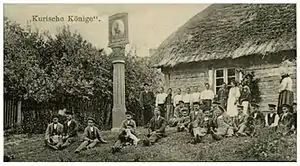Curonian Kings
Curonian Kings (Middle Low German: Cursken konyngh; German: Kurische Könige; Latvian: kuršu ķoniņi) are a Latvian cultural group, originally lesser vassals and free farmers that lived in seven villages between Goldingen (Kuldīga) and Hasenpoth (Aizpute) in Courland.



History
It is unclear how Curonian Kings gained their status, however, a popular assumption is that their ancestors were Curonian nobility prior to conquest by Livonian Order. They were first mentioned in a document of 1320 and lived in the villages of Ķoniņciems, Pliķu ciems, Kalējciems, Ziemeļciems, Viesalgciems, Sausgaļciems, and Dragūnciems (now in Kuldīga municipality). All of them possessed independent farms (did not belong to any lord), but they were not allowed to own their own serfs. They had only one landlord komtur of Kuldīga and they were related to him only by military service in case of war. Curonians usually served as a light cavalry in the Livonian Order army. Sources mention that Curonian Kings fought in the Livonian War against invading Russians, as Johann Renner's chronicle reports:
- The Russians protected themselves boldly, and they knocked out a Curonian cadet (who, although only a peasant, is called by them the Curonian king) from his horse.
- —Johann Renner, Lievländische Historien, 1556–1561, C. 124v
In 1504 master of the Livonian order Walter von Plettenberg awarded Curonian King Andrejs Peniķis, commander of the Curonian light cavalry for his loyal service during Livonian wars with Muscovite Russia.
It is known that in the 17th century Curonian Kings had their own coats of arms. In the Duchy of Courland and Semigallia they gradually lost their privileges, but they were still counted as a separate class. They were not recognized landlords but maintained a middle position between landlords and peasants. However, in the 18th century they were likened to serfs, although with smaller socage duties.
Their status was again recognized in 19th century, although they were not recognized as part of local nobility. In 1860 there were 833 Curonian kings living in Courland Governorate. While the Curonian tribe had long been assimilated by the Latvians, the Curonian Kings preserved a separate identity and traditions. Differences mandated by traditional rights disappeared as legal basis for them was removed by the Latvian Land Reform of 1920.
Traditions
The Curonian Kings also were allowed to practice some aspects of paganism during the period of Livonian Confederation. Despite formal Christianisation after Livonian Crusade Curonian Kings owned a sacred forest where nobody was allowed to hunt or walk. It is possible that the first mention in written sources of those sacred forests occurs in the record left by the Flemish knight Guillebert de Lannoy in 1414. In 1413–1414 he travelled through Livonia to Novgorod, and has left a short description of a Curonian funeral in his travel notes:[1]
The aforementioned Curonians, although they have been made Christian by force, have a sect that, instead of burying their dead, burns them in a nearby grove or forest, dressed and adorned with the finest ornaments, constructing a pyre entirely from oak wood; and they consider that if the smoke rises straight up to the heavens, then the soul is saved, but if it is blown to the side, then the soul is lost.
— Guillebert de Lannoy (1414)[2]
Their christmas traditions were described in a 16th century travel description by Königsberg apothecary Reinhold Lubenau:[2]
I first reached Mummel and then passed through Courland, reaching the Curonian king, where we had to watch his pagan superstitions. Since Christmas was approaching, they went hunting in their holy forest, where they do no hunting and do not cut a single rod throughout the rest of the year. All that they now hunted there: roe deer, red deer and hares, they skinned, cooked and placed on a long table. They fastened a large number of wax candles to the table, for the souls of their parents, children and relatives. After this, standing and walking to and fro, they ate and drank, and forced us to do likewise. Later, they brought an empty beer keg and beat on it with two sticks, and the men and women, as well as the children, danced around the table, something that continued for the whole night. When they went to bed one after another, they invited us to eat and take with us what we would, since they would not eat what was left over, but would give it to the dogs. Neither did they want to take any payment from us for what we had eaten.
— Reinhold Lubenau (20 December 1585)[2]
Notable Curonian Kings
- Mārtiņš Peniķis (1874–1964) – Latvian general, commander in chief of Latvian Army from 1928 to 1934.
- Ivars Tontegode (1983) – Latvian film director.
- Jānis Peniķis (1933) – Latvian political scientist.
References
- https://www.folklore.ee/folklore/vol42/laime.pdf
- Laime, Sandis (2009). "The Sacred Groves of the Curonian Ķoniņi: Past and Present" (PDF). Folklore. 42: 67–80. doi:10.7592/FEJF2009.42.laime.
- Free Latvians at 1800
- Алфавитный список народов, обитающих в Российской Империи. СПб., 1895 (in Russian)
- Meyers Konversations-Lexikon, 4. Auflage von 1888–1890. (in German)
- Voyages et ambassades de Messire Guillebert de Lannoy: chevalier de la Toison d'or, seigneur de Santes, Willerval, Tronchiennes, Beaumont et Wahégnies. 1399-1450
- https://www.letonika.lv/groups/?title=Kur%C5%A1u%20%C4%B7oni%C5%86i/32332